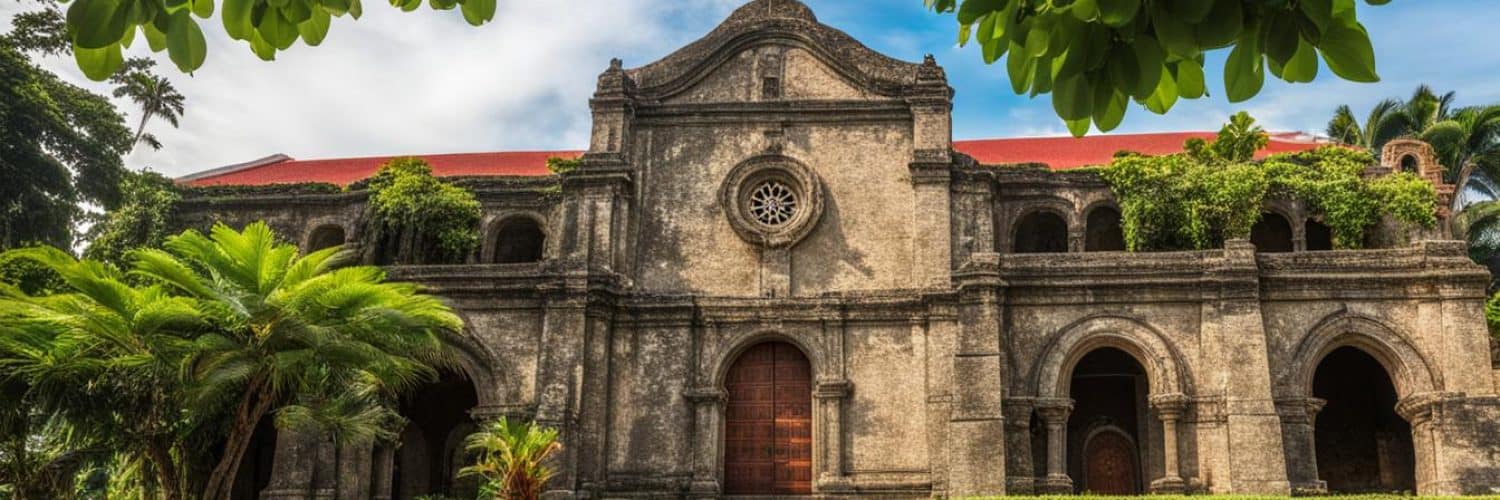Have you ever wondered what it’s like to step into a historical church that has stood the test of time? A cultural landmark that holds centuries of religious significance? Look no further than Sta. Monica Church in Capiz, Philippines. This famous church in Panay is not only a tourist attraction but also an architectural gem that will leave you in awe.
The rich history, grand structure, and unique features of Sta. Monica Church make it a must-visit destination for travelers seeking to explore the religious heritage of the Philippines, experience the cultural significance of Capiz, and marvel at the architectural brilliance of this historical church in Panay.
So, what makes Sta. Monica Church so special? Are you ready to uncover the secrets hidden within its walls? Let’s delve into the history, architecture, and significance of this magnificent church.
Key Takeaways:
- Sta. Monica Church (Capiz), Panay Philippines is a historical church and cultural landmark.
- It is a grand structure built in the Filipino Colonial Baroque style with Neo-Classical influence.
- The church is home to the largest church bell in Asia and the third biggest in the world.
- Sta. Monica Church holds great religious and cultural significance in the Philippines and has been recognized as a national cultural treasure.
- Visiting Sta. Monica Church is a chance to explore the rich history, architectural beauty, and local traditions in the area.
The History of Sta. Monica Church
The historical church in Capiz, known as Sta. Monica Church, holds a significant place in the religious heritage of the Philippines. Located on the island of Panay, it stands as the oldest church in the area, bearing witness to centuries of history and Spanish colonization. The church’s rich past and coral stone structure make it a remarkable testament to the country’s religious and cultural heritage.
Originally constructed between 1692 and 1698 under the supervision of Fr. Manuel Lopez, the church suffered destruction from a typhoon. In 1774, Fr. Miguel Murguia led the reconstruction efforts, only to face another detrimental typhoon in 1875. The resilient church was then restored once again in 1884 by Fr. Jose Beloso, preserving its historical significance and bringing it back to its former glory.
Sta. Monica Church’s coral stone structure is a distinctive feature that sets it apart from other religious sites in the Philippines. This architectural choice not only showcases the church’s durability but also adds to its unique beauty. The use of coral stones in construction was a common practice during the Spanish colonization era, and it remains a notable aspect of the church’s design.
The history of Sta. Monica Church is deeply intertwined with the Spanish colonization of the Philippines, reflecting the cultural and religious influence of the time. Its preservation and recognition as a national historical treasure highlight its importance in the country’s historical narrative. Visitors can explore this historical gem, marvel at its coral stone structure, and gain a deeper understanding of the religious heritage of the Philippines.
Historical Timeline of Sta. Monica Church
| Year | Event |
|---|---|
| 1692-1698 | Original construction of Sta. Monica Church under Fr. Manuel Lopez |
| 1774 | Reconstruction efforts led by Fr. Miguel Murguia |
| 1875 | Damaged by a destructive typhoon |
| 1884 | Restoration led by Fr. Jose Beloso |
Architecture and Design of Sta. Monica Church
Sta. Monica Church is a beautiful example of the Filipino Colonial Baroque style with Neo-Classical influence. The grand structure showcases the fusion of artistic elements that make it a visual masterpiece. Its walls, constructed with coral stone, stand three meters thick, providing durability and a stunning aesthetic. The church’s floor is adorned with luxurious marble, adding to its grandeur.
The architectural layout of Sta. Monica Church follows the shape of a Latin cross, symbolizing its religious significance. Within the church, visitors will find one large central altar and four lateral altars. These altars are adorned with breathtakingly decorated and gilded retablos, handcrafted from hardwood. Each retablo showcases an array of polychrome statues, representing various saints and religious figures, all of exceptional artistic quality.
“The intricate details of the retablos and the meticulous craftsmanship that went into creating them are a testament to the Filipino people’s devotion and reverence for their faith.”
Importance of Sta. Monica Church
Sta. Monica Church in Capiz, Philippines, is not just a cultural landmark but also a place of great religious significance. It holds a special place in the hearts and lives of the local community, serving as a center for worship and spiritual connection. The church’s historical preservation and maintenance efforts are crucial to safeguard its role as a national cultural treasure and a national historical landmark, as recognized by the National Museum and the National Historical Institute.
The cultural value of Sta. Monica Church cannot be overstated. It stands as a testament to the rich heritage and architectural prowess of the Philippines. The grand structure and intricate design of the church exemplify the country’s cultural identity and serve as a reminder of its storied past. Preserving this architectural gem ensures that future generations can appreciate the historical and religious significance it holds.
“Sta. Monica Church is a testament to the rich heritage and architectural prowess of the Philippines.”
Sta. Monica Church’s importance also extends beyond its physical attributes. It is a place where the local community gathers for religious ceremonies, community events, and cultural celebrations. The church plays a significant role in preserving and perpetuating local traditions and values, fostering a sense of belonging and shared identity among the people of Capiz.
Whether you are a history enthusiast, a religious pilgrim, or a curious traveler, visiting Sta. Monica Church is an opportunity to experience the cultural richness and historical depth of the Philippines. It is a chance to connect with the country’s past, witness its religious heritage, and appreciate the architectural beauty that has made this church a national cultural treasure and a national historical landmark.
The Significance of Sta. Monica Church
| Importance | Descriptor |
|---|---|
| National Cultural Treasure | Recognized by the National Museum |
| National Historical Landmark | Recognized by the National Historical Institute |
| Religious Significance | A place of worship and spiritual connection for the local community |
| Historical Preservation | Preservation efforts to safeguard its cultural and architectural value |
| Cultural Landmark | A symbol of the cultural identity of the Philippines |
Dakong Lingganay – The Largest Church Bell in Asia
One of the notable features of Sta. Monica Church is Dakong Lingganay, which translates to “big bell” in English. It is the largest church bell in Asia and holds great historical significance. The bell was built during the historic Spanish era and measures a remarkable 7 feet in diameter. With a weight of 23,000 pounds, it is an impressive testament to the craftsmanship of the time.
The creation of Dakong Lingganay was made possible by the generous donation of 70 sacks of coins from the townsfolk. The bell’s size and weight demonstrate the commitment and dedication of the community to their church and the significance they attributed to the historic Spanish era.
The original Dakong Lingganay hangs in the church’s renowned 5-story belfry, providing a constant reminder of its cultural and historical importance. Visitors can marvel at its sheer size and imagine the powerful toll that once resonated through the town of Panay.
For those who wish to get a closer look at Dakong Lingganay, a replica of the bell is prominently displayed near the Museo de Santa Monica within the church compound. This replica allows visitors to appreciate the intricate details and craftsmanship that went into creating such a monumental piece of history.
This image showcases the magnificent size and grandeur of Dakong Lingganay, emphasizing its significance within the context of Sta. Monica Church and the surrounding historical landscape.
The Historical Significance of Panay
The town of Panay, where Sta. Monica Church is located, has a rich history tied to the Spanish colonization of the Philippines. The original name of the settlement was Bamban, which was changed to Panay by early Spaniards. The name Panay means “mouth of the river” and signifies the location of the town. Panay was also the site of a fortress built by Juan de la Isla in the late 16th century. The town’s historical significance is further enhanced by the presence of an old Spanish well, which still contains water and serves as a reminder of the past.
“The town of Panay holds a rich historical legacy, dating back to the Spanish era. It was once a bustling settlement that played a significant role in the colonization of the Philippines. Today, it stands as a testament to our shared history.” – Local Historian
Visiting Sta. Monica Church
If you’re planning a visit to Sta. Monica Church in Panay, there are several transportation options available. Here’s a guide to help you get there:
By Air:
If you’re coming from Manila, the quickest way to reach Panay is by booking a flight to either Caticlan or Kalibo airports. From there, you can easily proceed to Sta. Monica Church.
- From Caticlan Airport, you can take a Ceres bus to Iloilo and get off at the Sigma bus stop. The bus fare from Caticlan is approximately PHP 215.
- If you arrive at Kalibo Airport, you can also take a Ceres bus to Iloilo and get off at the Sigma bus stop. The bus fare from Kalibo is about PHP 107.
By Land:
If you prefer a scenic journey, you can also travel from Manila to Panay by land. Here’s how:
- Take a bus or private vehicle to Roxas City. There are several bus companies offering trips to Roxas City from various terminals in Manila.
- Once you reach Roxas City, you can hire a tricycle to take you to the terminal for Panay-bound tricycles. The fare from the terminal to Panay is approximately PHP 15 per person.
If you’re an adventurous traveler, you can also consider taking a jeepney ride from Roxas City to Panay for a more local experience.
Regardless of the transportation option you choose, reaching Sta. Monica Church in Panay is definitely worth the journey. Prepare to be captivated by the historical charm and cultural significance of this magnificent church.
Explore the Interior of Sta. Monica Church
The interior of Sta. Monica Church is a sight to behold, matching the remarkable beauty of its exterior. As you step inside, you’ll be greeted by the breathtaking design and intricate details of the church. The walls, made of cemented coral stones, exude a sense of solidity and strength, reflecting the heritage of the structure.
The pillars of the church are adorned with arched windows, showcasing stunning European carvings. These windows bring in natural light, creating a serene and uplifting atmosphere within the church. The columns, intricately carved, are a tribute to European craftsmanship and add a touch of elegance to the space.
As you explore further, you’ll come across a variety of decorative statues and religious artifacts that adorn the interior. These statues, carefully placed on the crannies of the church walls, depict saints such as Saint Thomas, Saint Agustin, and Saint Monica. Their presence adds to the religious ambiance and artistic appeal of the space, inviting contemplation and reverence.
Whether you’re an architecture enthusiast, a religious devotee, or simply seeking a peaceful and awe-inspiring experience, the interior of Sta. Monica Church will captivate your senses and leave a lasting impression. Take your time to appreciate the exquisite design, the significance of the religious artifacts, and the craftsmanship that went into creating this remarkable place of worship.
Museo de Santa Monica – Exploring the Church Compound
Within the church compound, you’ll find the Museo de Santa Monica. This museum is a treasure trove of historical artifacts that offer a fascinating glimpse into the rich heritage of Sta. Monica Church and the town of Panay.
The Museo de Santa Monica provides visitors with an immersive experience, allowing them to delve deeper into the cultural significance of the area. The museum showcases a diverse collection of items that span different eras, including religious artifacts, artworks, and archaeological discoveries. These artifacts serve as windows to the past, enabling visitors to understand and appreciate the historical context in which the church and the town have evolved.
One of the highlights of the museum is the replica of Dakong Lingganay, which stands as a testament to the awe-inspiring originality of the church bell. As the largest church bell in Asia, Dakong Lingganay holds immense historical and cultural significance. The replica offers a close-up view of this magnificent bell, allowing visitors to appreciate its size and craftsmanship. It is a must-see attraction that adds to the allure of the museum.
Additionally, as you explore the church compound, you’ll come across an old Spanish well that further enhances the authenticity and charm of the site. This well serves as a reminder of the town’s colonial past and provides a unique perspective on the historical context in which Sta. Monica Church was built.
The Museo de Santa Monica, with its collection of historical artifacts, replica of Dakong Lingganay, and the presence of an old Spanish well, offers a comprehensive and enlightening experience for all visitors. It is a testament to the commitment to preserving the rich cultural heritage of Sta. Monica Church and Panay, inviting guests to embark on a journey through time and gain a deeper understanding of the region’s history.
| Artifacts | Description |
|---|---|
| Religious Artifacts | A collection of religious items, including religious statues, crucifixes, and prayer books. |
| Archaeological Discoveries | Artifacts from archaeological excavations, such as pottery, tools, and ornaments. |
| Artworks | A display of artworks that reflect the cultural and artistic traditions of the region. |
| Dakong Lingganay Replica | A replica of the largest church bell in Asia, providing a close-up view of its intricate details. |
| Spanish Well | An old Spanish well that serves as a historical landmark within the church compound. |
Preservation Efforts and Recognition
Sta. Monica Church and its surrounding compound have received significant recognition and protection due to their historical and cultural value. The National Historical Institute, under Resolution No. 3, has declared the church a national historical landmark, affirming its importance in Philippine history. Additionally, the National Museum has recognized Sta. Monica Church as a national cultural treasure, highlighting its cultural significance for the nation.
Preservation and maintenance efforts have been put in place to safeguard the historical and architectural integrity of Sta. Monica Church. These recognitions are a testament to the importance of preserving this magnificent structure for future generations.
By protecting and maintaining this iconic church, the national resolution and recognitions aim to ensure that the historical and cultural value of Sta. Monica Church remains intact. These efforts are vital for the continued appreciation and study of this national treasure.
| Recognition | Organizations |
|---|---|
| National Historical Landmark | National Historical Institute |
| National Cultural Treasure | National Museum |
With the support of these national institutions, the preservation of Sta. Monica Church has been prioritized, solidifying its status as a cornerstone of Philippine history and culture.
Sta. Monica Church and its surroundings have been recognized for their historical and cultural value.
Significance to the Local Community
Sta. Monica Church holds a significant place in the hearts and lives of the local community in Panay. It serves as a place of worship, where religious activities, community gatherings, and various local traditions take place. The church is also the site of cultural events and religious festivals that bring the community together. Its role extends beyond its historical and architectural value, making it a cherished symbol of religious and cultural identity for the people of Panay.
Surrounding Attractions in Panay
While exploring the historic beauty of Sta. Monica Church in Panay, don’t miss out on the opportunity to discover the captivating attractions that surround this charming town. Whether you’re a history enthusiast, a nature lover, or simply looking for interesting destinations to visit, Capiz has something to offer for everyone.
Capiz Provincial Capitol
If you appreciate elegant architecture and want to learn more about the local government, a visit to the Capiz Provincial Capitol is a must. This iconic landmark showcases stunning architectural design and serves as the seat of the provincial government. Capture picturesque moments against the backdrop of this magnificent building and admire its grandeur.
Capiz Bridge
Known as the “Longest Spanish Era Bridge in Panay,” the Capiz Bridge is another attraction worth exploring. As you stroll along this historic bridge, take in the panoramic views of the surrounding landscape while immersing yourself in the region’s rich history. Feel the ambiance of the past and embrace the nostalgic charm this bridge exudes.
Natural and Historical Sites
Aside from the architectural marvels, Panay offers various natural and historical sites that provide insight into the region’s heritage and natural beauty. From lush parks and gardens to ancient ruins and landmarks, there are plenty of destinations waiting to be discovered. Embark on a journey to these sites to gain a deeper understanding of Capiz’s rich history and experience the serene and breathtaking beauty of its natural landscapes.
Plan your itinerary to include nearby attractions such as Napti Island, Baybay Beach, and Santa Ana Church to make the most of your visit. With its combination of cultural landmarks, historical sites, and natural wonders, Capiz promises an unforgettable experience for all who visit.
| Tourist Attractions in Capiz | Description |
|---|---|
| Napti Island | Experience the pristine beauty of this unspoiled island paradise. Go snorkeling, swimming, or simply relax on the pristine white sandy beaches. |
| Baybay Beach | Spend a leisurely day at this bustling beach, known for its sparkling waters and vibrant atmosphere. Enjoy a picnic, indulge in water sports, or stroll along the promenade. |
| Santa Ana Church | Discover the historical and spiritual significance of this centuries-old church. Marvel at its architectural beauty and learn about its role in the local community. |
| Codcod Rice Terraces | Immerse yourself in the breathtaking landscapes of the Codcod Rice Terraces. Witness the ingenuity of the locals in cultivating rice in these stunning terraces. |
Experience the Rich Culture and Heritage of Panay
A visit to Panay offers the opportunity to immerse yourself in the rich culture and heritage of the region. Experience the vibrant traditions and explore the roots of the local community through various cultural immersions in Panay.
Traditional Crafts
Witness the skilled artisans at work, creating intricate products that showcase the local craftsmanship. From handwoven textiles to delicately carved wooden pieces, Panay is a treasure trove of traditional crafts. Take the time to visit local workshops and learn about the traditional techniques passed down through generations.
Local Delicacies
No visit to Panay is complete without savoring the unique flavors and culinary expertise of the local delicacies. Indulge in mouthwatering dishes that highlight the region’s abundance of fresh seafood, flavorful spices, and traditional cooking methods. From the famous seafood sinigang to the delightful batchoy soup, every bite is a journey into the local gastronomy.
Cultural Performances
Immerse yourself in the vibrant cultural scene of Panay through mesmerizing cultural performances. Be captivated by traditional dances that tell stories of a rich history and showcase the unique heritage of the region. Let the enchanting melodies of traditional music transport you to a bygone era. Experience the energy, passion, and artistry of the local performers.
Heritage Tours
Delve deeper into the history and heritage of Panay through guided heritage tours. Explore ancient landmarks, historical sites, and architectural wonders that narrate the story of the region. Learn about the struggles, triumphs, and traditions that have shaped the local culture. Immerse yourself in the fascinating narratives of Panay’s past and uncover hidden gems along the way.
| Experience | Description |
|---|---|
| Traditional Crafts | Witness skilled artisans showcasing their craftsmanship in various workshops. |
| Local Delicacies | Savor the unique flavors and culinary expertise of Panay’s local delicacies. |
| Cultural Performances | Experience the vibrant cultural scene through traditional dances and music. |
| Heritage Tours | Delve deeper into the history and heritage of Panay with guided tours. |
Capturing Memories at Sta. Monica Church
Sta. Monica Church is not just a sight to behold but also a popular spot for capturing memories. The magnificent architecture and unique design make it an ideal subject for architectural photography. Whether you’re a professional photographer or simply looking for photo opportunities, Sta. Monica Church offers captivating visuals and a sense of timeless beauty.
Architectural Photography
The grand structure of Sta. Monica Church, with its coral stone walls and impressive dimensions, provides the perfect subject for architectural photography. Capture the intricate details of the Filipino Colonial Baroque style blended with Neo-Classical influence. From the arched windows to the richly decorated altars, every corner of the church offers a unique photo opportunity.
Picturesque Backdrop for Religious Ceremonies
Sta. Monica Church is not just a place of worship but also a popular venue for religious ceremonies. Whether it’s a baptism, a holy matrimony, or another special event, the church’s timeless beauty serves as a picturesque backdrop for capturing the sacred moments. Witness the interplay of light and shadow within the hallowed halls, and immortalize the emotions and joy of these occasions.
“Sta. Monica Church is like a living artwork, a testament to the architectural genius of the past. As a photographer, I was captivated by the play of light and shadow, the intricate details carved into the altars, and the overall grandeur of the structure. It’s a photographer’s paradise.” – Maria Delgado, Architectural Photographer
Wedding Venue of Timeless Beauty
If you’re planning a wedding, look no further than Sta. Monica Church. The stunning architecture and historic charm create a romantic ambiance that will make your special day truly memorable. The church’s elegant interior and beautiful surroundings provide the perfect backdrop for your wedding photographs, ensuring a timeless reminder of your love and commitment.
Whether you’re a photography enthusiast, a soon-to-be-wed couple, or simply seeking photo opportunities in a breathtaking setting, Sta. Monica Church is a place that will inspire and captivate you. Don’t miss the chance to capture the beauty and essence of this architectural gem.
Conclusion
Sta. Monica Church in Panay, Capiz, Philippines, is a truly remarkable destination that combines religious heritage, cultural significance, and architectural beauty. This historical church stands as a cultural landmark and architectural gem of Panay, captivating visitors with its grand structure and captivating design. Whether you’re exploring the exquisite Filipino Colonial Baroque architecture, immersing yourself in the rich interior, or venturing out to discover the surrounding attractions, a visit to Sta. Monica Church promises a memorable and enriching experience.
As one of the oldest churches in Panay, Sta. Monica Church carries with it a deep sense of religious heritage and plays an important role in the history of the Philippines. Its coral stone walls, towering ceilings, and gilded retablos are a testament to the centuries of worship and devotion that have taken place within its walls. With its designation as a national cultural treasure and national historical landmark, the preservation and recognition of Sta. Monica Church are paramount to safeguarding the country’s cultural legacy.
For travelers seeking a unique travel destination that combines architectural marvels, historical significance, and cultural immersion, Sta. Monica Church is a must-visit. Explore the intricacies of its design, soak in the atmosphere of religious reverence, and venture out to explore the nearby attractions that Capiz has to offer. From natural wonders to historical sites, the area surrounding Sta. Monica Church is a treasure trove waiting to be discovered. Experience the rich religious and cultural heritage of the Philippines and create lasting memories at this iconic and beloved historical church.


















Add comment